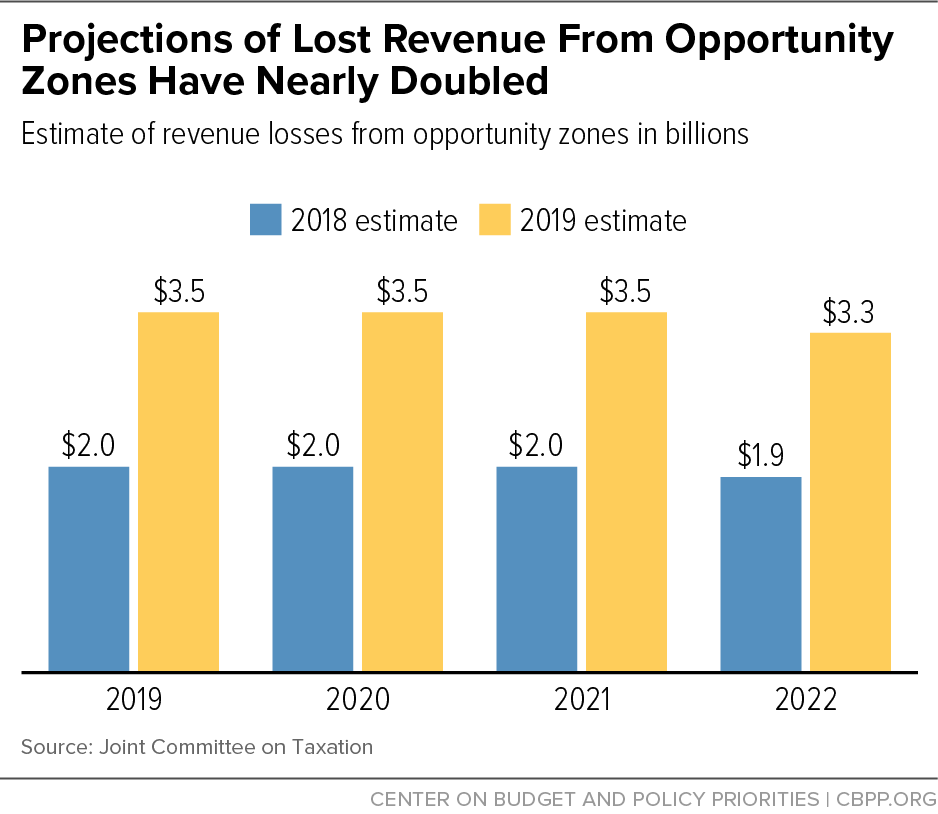BEYOND THE NUMBERS
In finalizing its regulations on the 2017 tax law’s “opportunity zones,” the Treasury Department took some questionable business giveaways that were included in its proposed regulations and actually expanded them.
The Joint Committee on Taxation (JCT) has nearly doubled its estimate of the zones’ cost in lost federal revenue, and the new regulations could raise those costs even more. Given that, in its final regulations, Treasury failed to significantly curb opportunities for abuse or to ensure that opportunity zones fulfill their ostensible purpose of benefiting low-income areas, policymakers should evaluate how the program is working, who really benefits, and how to prevent widespread tax avoidance — and then adjust the law as needed.
The opportunity zone provision lets investors defer taxes that they would otherwise owe on capital gains (profits they realize when selling an asset, such as stock) by “rolling” these gains into funds (known as OZ funds) that invest in low-income areas. If investors keep their interests in these OZ funds for a certain number of years, they can qualify for additional tax breaks — including a permanent tax exemption on all gains they realize on their opportunity zone investments through 2047.
The 2017 tax law’s opportunity zone provisions were already vague, and Treasury’s proposed regulations in many cases would have made it easier for investors to claim tax benefits for only minimal investments. Moreover, many designated zones are ripe for high-end investments (like luxury apartments) that likely wouldn’t generate significant benefits for low-income residents, as we’ve written. We and others therefore urged Treasury to use its regulatory authority to help prevent the zones from becoming tax shelters. Instead, the final regulations will let investors claim tax breaks for even broader activities than the proposed ones.
For example, the final regulations:
- Let more types of gains qualify for tax breaks. In perhaps the final regulations’ most investor-friendly change, investors in businesses can defer taxes on more types of gains — in particular, gains from the sales of certain business assets like real estate or heavy equipment. Under the tax code’s normal rules, businesses combine their gains and losses from the sales of these assets. Net gains from their sales in a particular year result in capital gains on which businesses pay capital gains taxes, and net losses let businesses take a tax deduction from their ordinary income (for example, sales income). That means that businesses typically must wait until the end of the year to determine their overall gain or loss, and the proposed regulations would have followed that approach. Under the final regulations, though, businesses can calculate each sale on its own, giving them the best of both worlds: they can get the opportunity zone tax breaks for each gain, and they can get a full deduction for each loss.
Assume, for example, that an opportunity zone investor sold two business assets in a year — one for a $1 million gain, and the other for a $200,000 loss. Under the proposed regulations, the investor could have rolled the net gain of $800,000 into an opportunity zone. But under the final regulations, the investor can put the $1 million gain into an opportunity zone, get full tax breaks on it, and still deduct the $200,000 loss from ordinary income. - Require fewer improvements for opportunity zone property. The law requires opportunity zone investors and businesses to “substantially improve” — that is, make major investments in — already used assets that they buy, such as real estate in an opportunity zone. Under the proposed regulations, businesses would have had to improve each asset. Under the final regulations, however, they can make improvements on an aggregate basis in some cases. If, for example, a fund owns two buildings in an opportunity zone, it may only need to improve one of those buildings while essentially holding the other as an investment property.
- Let businesses hold cash for longer, making communities wait. To prevent investors from benefiting from opportunity zone tax breaks simply by keeping cash in the bank rather than putting the money into those communities, the law limits the amount of cash that a qualifying business can hold. But the proposed regulations included a generous exception, letting businesses qualify for the tax breaks even if they hold all their assets in cash for up to 31 months. Now, the final regulations expand this exception dramatically — letting some businesses qualify for tax breaks without making any tangible investment in opportunity zones for more than five years.
We’ve seen similar dynamics play out in other areas of the 2017 tax law, with lobbyists using the regulatory process to secure significant new tax breaks that mainly benefit multinational corporations and very affluent owners of certain kinds of businesses. And when Treasury issues overly lenient regulations, investors can claim tax breaks for a larger set of activities, which can cost taxpayers even more.
In its most recent projections, JCT estimates that opportunity zones will cost about $3.5 billion a year from 2019 through 2022. That’s nearly double what it estimated in 2018 for this tax break. (See chart.) The final regulations’ investor-friendly rule changes create the potential for opportunity zones’ costs to go even higher than current estimates — with no guarantee that low-income areas, or their residents, will benefit.

